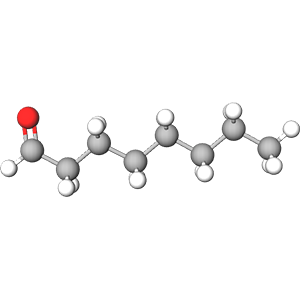

Aldehyde C-8, or Octanal, possesses a sharp, citrus-fruity scent with sweet, woody, and slightly floral undertones. It is prominent for its role in imparting a fresh, citrusy aroma, reminiscent of oranges and lemons, making it a staple in Eau-de-Colognes, and a variety of citrus and floral compositions. Its versatility allows it to blend well with other components to create rich, nuanced fragrances.
Extensively used to achieve or enhance citrus, fruity, and floral notes in perfumes. Especially valued in Eau-de-Colognes, fresh topnotes, and in compositions featuring orange blossom, neroli, and other citrus and floral themes.
IUPAC Name: octanalCAS Number: 124-13-0
Molecular Formula: C8H16O
Molecular Weight: 128.21 g/mol
Boiling Point: 171.00 °C
Melting Point: -23.00 °C
Class: Aldehyde
Use/s: Scent
Synonyms
1: Octanal 2: Caprylaldehyde 3: Caprylic aldehyde 4: n-Octanal 5: 1-octanal 6: n-Octyl aldehyde 7: n-Octaldehyde 8: n-Caprylaldehyde 9: Octanaldehyde
Chemist Says
N-octylaldehyde is a colorless liquids with a strong fruity odor. Less dense than water and insoluble in water. Flash points 125 °F. Used in making perfumes and flavorings.
Scent: Fruity, Orange
Scent profile
Scent profiles are inherently subjective and can significantly differ among individuals, and may also be influenced by the conditions at the time of evaluation. The information provided here is a synthesis of data from diverse sources, including books, cross-references, artificial intelligence analyses, and chemical research sites, aiming to present a comprehensive overview. We've distilled this information to highlight the most frequently observed scent profiles for each molecule or compound, offering a generalized perspective.
1: Citrus, Fruity, Sweet, Woody, Floral, Honey, Green, Lemon-Lime
2: Citrus, Fruity, Slightly Floral
3: Strong, fruity odor
4: Citrusy, soapy, with a strong and unpleasant character
 Flammable
Flammable Irritant
Irritant Environmental Hazard
Environmental Hazard